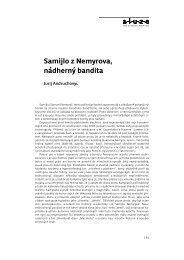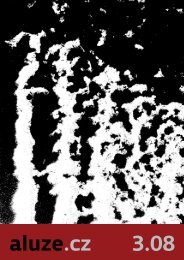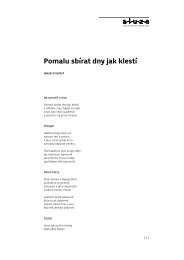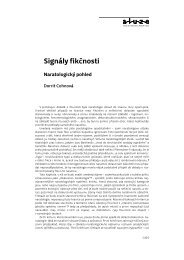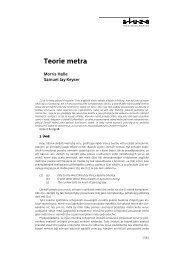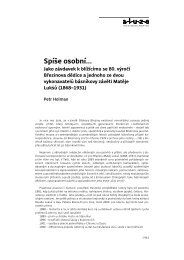StáhnÄte si celé ÄÃslo ve formátu PDF - Aluze
StáhnÄte si celé ÄÃslo ve formátu PDF - Aluze
StáhnÄte si celé ÄÃslo ve formátu PDF - Aluze
Create successful ePaper yourself
Turn your PDF publications into a flip-book with our unique Google optimized e-Paper software.
[studie]<br />
ALUZE 2/2009 – Revue pro literaturu, filozofii a jiné<br />
Poznámky:<br />
1 Srov. Keith C. Sewell, „The ,Herbert Butterfield Problem’ and Its Resolution“, Journal of the History<br />
of Ideas 64, 2003, s. 599–618; Keith C. Sewell, Herbert Butterfield and the Interpretation of<br />
History, London, Macmillan 2005, s. 30–47. Sám Butterfield sepsal také hojně užívanou a vlivnou<br />
práci Origins of Modern Science (1949), která je však dnes jednoznačně považována za<br />
whigovskou; srov. např. Regis Cabral, „Herbert Butterfield (1900–1979) as a Christian Historian<br />
of Science“, Studies in History and Philosophy of Science 27, 1996, s. 547–564.<br />
2 Přehled těchto diskusí podává např. Nick Jardine <strong>ve</strong> studii „Whigs and Stories: Herbert Butterfield<br />
and the Historiography of Science“, History of Science 61, 2003, s. 125–140.<br />
3 Taková představa se často objevuje v různých populárních přehledech dějin vědy. Například<br />
matematik Jakob Bronowski charakterizuje svůj pohled na dějiny vědy takto: „Ona dlouhá řada<br />
objevů a vynálezů, kterými člověk po celé věky přetvářel své prostředí, nepředstavuje už biologický,<br />
ale kulturní vývoj. Nazval jsem tento skvělý sled kulturních výkonů směřujících k vyšším<br />
metám vzestupem člověka.“ Jakob Bronowski, Vzestup člověka, přel. J. Davidová-Moserová,<br />
Praha, Odeon 1985, s. 10.<br />
4 Viz například Richard Jones, „The Historiography of Science. Retrospect and Future Challenge“,<br />
in: Michael Shortland – Andrew Warwick (eds.), Teaching the History of Science, Oxford,<br />
Blackwell 1989, s. 80–99; Andrew Cunningham – Perry Williams, „De-centring the ‚big picture‘:<br />
The Origins of Modern Science and the modern origins of science“, British Journal for the History<br />
of Science 26, 1993, s. 407–432; J. R. R. Christie, „Aurora, Neme<strong>si</strong>s and Clio“, British Journal for<br />
the History of Science 26, 1993, s. 391–405; Margaret J. Osler, „The Canonical Imperati<strong>ve</strong>:<br />
Rethinking the Scientific Revolution“, in: Margaret J. Osler (ed.), Rethinking the Scientific Revolution,<br />
Cambridge, Cambridge Uni<strong>ve</strong>r<strong>si</strong>ty Press 2000, s. 3–22.<br />
5 Diskuze o povaze anachronismů v historických oborech včetně historie vědy je poměrně spletitá<br />
– vynikající přehled s odkazy na další literaturu podává Carlos Spoerhase v rozsáhlé studii<br />
„Zwischen den Zeiten: Anachronismus und Präsentismus in der Methodologie der historischen<br />
Wissenschaften“, Scientia Poetica 8, 2004, s. 169–240. Častým východiskem úvah o anachronismech<br />
(včetně Spoerhasovy) bývá slavné metodologické pojednání anglického historika ofie<br />
Quentina Skinnera „Meaning and Understanding in the History of Ideas“, History and Theory 8,<br />
1969, s. 3–53.<br />
6 Příklady anachronismů uváděné v dalším textu byly vybrány spíše namátkou z prací několika<br />
různých současných i starších autorů – opakované uvádění těchto prací jako zdrojů anachronismů<br />
neznamená, že se jedná o práce, které v jiných ohledech nemají dostatečnou odbornou<br />
úro<strong>ve</strong>ň.<br />
7 Pojem disciplinární matice za<strong>ve</strong>dl Thomas Kuhn v „Dodatku“ ke Struktuře vědeckých revolucí<br />
z roku 1969 v poněkud sofistikovanějším vymezení, než je předsta<strong>ve</strong>no zde; viz Thomas Kuhn,<br />
Struktura vědeckých revolucí, přel. T. Jeníček, OIKOYMENH, Praha 1997, 181n.<br />
8 Andrew Cunningham, „Getting the Game Right: Some Plain Words on the Identity and In<strong>ve</strong>ntion<br />
of Science“, Studies in History and Philosophy of Science 19, 1988, s. 365–389.<br />
9 Robert E. Krebs, Groundbreaking Scientific Experiments, In<strong>ve</strong>ntions, and Disco<strong>ve</strong>ries of<br />
the Middle Ages and the Renaissance, Westport – London, Greenwood Press 2004, s. 1.<br />
10 Tamtéž, s. 155.<br />
11 Viz například kla<strong>si</strong>ckou práci Mirca Eliade, Mýtus o věčném návratu, přel. E. Streibingerová,<br />
Praha, OIKOYMENH 1993.<br />
12 Sydney Ross, „Scientist: The Story of a Word“, Annals of Science 18, 1962, s. 65–85; Andrew<br />
Cunningham – Perry Williams, „De-centring the ‚big picture‘: The Origins of Modern Science and<br />
the modern origins of science“, s. 418–421. Anglosasští historikové nepovažují za nutné zkoumat<br />
dějiny pojmu „věda“ v dalších jazycích a považují sémantiku vlastního jazyka za dostatečně<br />
přesvědčivý doklad.<br />
13 K dějinám pojmu scientia (epistémé) viz S. Maier-Oeser, „Wissenschaft“, in: Joachim Ritter –<br />
Karl Gründer (eds.), Historisches Wörterbuch der Philosophie, 13 sv., Basel, Schwabe 1971–2007,<br />
sv. 12, s. 902–915; srov. též Marek Otisk, Metafyzika jako věda. Ibn Síná a Ibn Rušd <strong>ve</strong> scholastické<br />
disku<strong>si</strong>, Praha, Filosofia, 2006.<br />
14 Premoderní kla<strong>si</strong>fikace vědění jsou značně komplikované a u<strong>ve</strong>dený nástin je <strong>ve</strong>lmi zjednodušený.<br />
Podrobnější přehled lze najít například v těchto pracích: James A. Weisheipl, „The Nature,<br />
Scope, and Clas<strong>si</strong>fication of the Sciences“, in: David Lindberg (ed.), Science in Middle Ages, Chicago,<br />
Uni<strong>ve</strong>r<strong>si</strong>ty of Chicago Press 1978, s. 461–482; Eleonore Serene, „Demonstrati<strong>ve</strong> Science“,<br />
in: Norman Kretzmann, Anthony Kenny, Jan Pinborg, The Cambridge History of Later Medieval<br />
Philosophy: From the Redisco<strong>ve</strong>ry of Aristotle to the Di<strong>si</strong>ntegration of Scholasticism,1100–1600,<br />
Cambridge, Cambridge Uni<strong>ve</strong>r<strong>si</strong>ty Press 1988, s. 496–517; Nick Jardine, „Epistemology of the<br />
sciences“, in: Charles Schmitt – Quentin Skinner (eds.), The Cambridge History of Renaissance<br />
Philosophy, Cambridge, Cambridge Uni<strong>ve</strong>r<strong>si</strong>ty Press 1991, s. 685–711.<br />
15 Isaac Newton, Principia mathematica philosophiae naturalis [1687], Londini 1726 3 , s. 387–<br />
389; srov. Andrew Cunningham, „How the Principia Got Its Name: Or, Taking Natural Philosophy<br />
[ 69 ]



